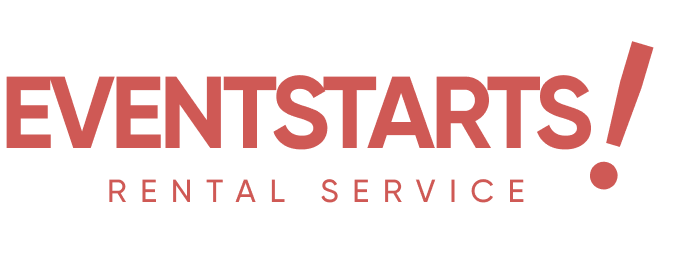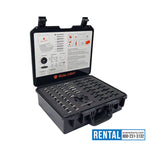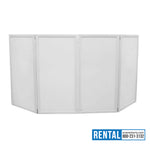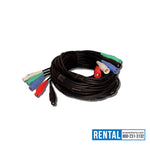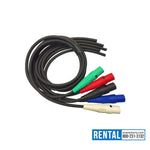You have no items in your shopping cart.
The Ultimate Outdoor Stage Lighting Setup Guide
When planning an unforgettable outdoor event—whether it’s a live concert, festival, theater production, or corporate gathering—stage lighting is one of the most crucial elements. Proper lighting doesn't just illuminate performers; it defines mood, enhances visuals, and elevates the audience's entire experience. Whether you're working with portable staging, custom stage designs, or large modular staging systems, choosing and setting up the right lighting system can make or break your event.
In this comprehensive guide, we’ll walk you through every critical component of an outdoor stage lighting setup, from understanding lighting types to planning power needs, choosing the right trussing and rigging, integrating lighting with custom stage rental structures, and avoiding the most common mistakes.
Why Stage Lighting Matters So Much
Lighting does more than just make people visible. It tells a story, emphasizes moments, and creates depth and emotion on stage. Especially outdoors, where ambient lighting can’t be controlled as easily as indoors, the quality of your stage lighting becomes even more vital.
With modern stage setup services, event organizers can craft lighting installations tailored to each event’s scale and creative vision—whether it’s a massive rock festival or a refined dance recital on custom-shaped stages.
Understanding the Basics: Types of Outdoor Stage Lighting
An effective lighting setup combines various fixture types, each with its specific role. Here are the essentials:
Spotlights
Used to highlight specific performers or focal points. For concerts and presentations, spotlights follow movement and draw attention to key moments.
Wash Lights
These provide broad illumination across wide areas. Wash lights are essential for base-level lighting, especially on larger portable event stages.
PAR Cans
Classic, durable, and weather-resistant, PAR (Parabolic Aluminized Reflector) lights deliver solid illumination and are ideal for front lighting or filling large backdrops.
Moving Head Lights
These intelligent lights can tilt, pan, change color, and move in sync with music. Their dynamic nature is perfect for high-energy shows on modular stages.
Floodlights and Blinders
These produce intense, broad light coverage. They're excellent for lighting up the crowd or creating visual impact at pivotal moments.
Uplighting
Positioned at the base of custom-fit staging, uplighting adds depth and mood to scenic elements and stage structures.
LED Bars and Panels
Highly customizable and energy-efficient, LED lights can line stage perimeters, risers, and trusses. They work beautifully with precise fit stages to outline structure.
Adapting to Outdoor Conditions
Unlike indoor events, outdoor lighting setups face unpredictable elements like weather, temperature swings, wind, and ambient daylight. This means every piece of gear must be outdoor-rated (IP-rated for water resistance), properly rigged, and safely powered.
Here’s what you need to consider:
-
Use weatherproof fixtures and connectors
-
Ensure stable anchoring and windproof rigging
-
Account for sunset and lighting transition timing
-
Prepare for temperature-related color shifts in lights
-
Incorporate redundancy into power and control systems
Professionals in stage installation know that nature adds complexity to your lighting plan—but with the right prep, it also offers dramatic, unforgettable effects.
Planning the Stage Layout Around Lighting
The shape and size of your stage drastically affect how you approach lighting. A custom stage rental might include raised runways, multi-level decks, or even custom-shaped stages. Each layout will need a unique lighting plan.
Modular and Custom-Fit Stages
With modular staging systems, flexibility is key. Since these stages can be configured into various dimensions and elevations, your lighting should be adaptable too. This often includes mobile trussing systems or tower lighting stands that can adjust in height and angle.
Trussing and Rigging Systems
Trussing is the framework that holds lighting above and around the stage. Outdoor events require either:
-
Ground-supported trusses for portability and flexibility
-
Roofed truss systems for larger productions and protection from rain
-
Goalpost-style trussing for minimal setups with effective coverage
Integrate trussing with your stage rental to ensure the rig is stable, balanced, and easy to access for maintenance or emergency changes.
Integrating Lighting with Staging Design
Work closely with your staging team. Custom stage designs allow creative lighting cues to be built right into the structure—like LED strips under stairs, floodlights embedded in risers, or uplighting hidden within set pieces.
Power and Control: Behind the Scenes
Your outdoor lighting setup is only as reliable as its power and control systems. Poor planning here leads to flickering lights, power cuts, or complete failure.
Power Distribution
Calculate total wattage of all lighting fixtures and account for peak draw. Outdoor events typically rely on generators, so make sure you:
-
Use high-quality, silent-run generators
-
Distribute power across multiple circuits to prevent overload
-
Include backup power options for emergency lighting
Distribute cables safely along designated routes and cover them with ramps or runners, especially in high-traffic event stage setup areas.
DMX and Lighting Control
Most professional lighting uses DMX512 or ArtNet control protocols. Lighting desks and software like GrandMA, ChamSys, or Lightkey provide precise cue management, color programming, and synchronization with sound.
Wireless DMX and remote control tablets can save setup time and allow technicians to make changes from various points around portable stage rental setups.
Lighting Design for Different Outdoor Event Types
Let’s look at how lighting setups differ by event type:
Music Festivals and Concerts
These are high-energy environments requiring synchronized lights, vivid color effects, strobing, and motion tracking. Often integrated with pyrotechnics and video walls, concert lighting setups need:
-
Multiple moving heads and beam lights
-
Truss towers placed throughout crowd areas
-
Time-coded programming for music synchronization
-
Smoke or haze machines to emphasize beams
Here, event staging must support heavy rigging and offer backstage access for quick changes.
Corporate Events and Speeches
Lighting here should focus on clarity, brand colors, and elegance. Wash lights and color-matched uplighting on custom-fit staging can match the event's theme. Minimalistic lighting works best—spotlights for speakers, soft backdrops, and low-glare options for video capture.
Theater and Dance Performances
Precision is key. Front lighting must prevent shadows, side lighting emphasizes movement, and color washes add atmosphere. Using portable staging with integrated side lighting towers allows for dynamic light choreography without obstructing the audience’s view.
Weddings and Celebrations
Decorative lighting plays a bigger role than stage lighting. Uplights, bistro string lights, and warm color tones define the mood. Still, if there’s a performance or band, proper stage lighting—combined with a portable event stage—ensures guests can enjoy every moment.
Common Mistakes and How to Avoid Them
Ignoring Venue Conditions
Too often, lighting plans are made without a site visit. Visit your venue early, or ask your stage setup services provider for detailed site specs. Note terrain, sun angles, wind patterns, and accessibility.
Overcomplicating the Setup
Using too many lighting types can confuse the audience and make syncing more difficult. Start with a strong base (wash + spots) and add effects only where they enhance the performance.
Underestimating Load and Rigging
Outdoor stage installation often means dealing with uneven ground, wind gusts, and changing weather. Ensure trusses and lighting fixtures are rated for outdoor loads, and always have certified riggers handle installations.
Forgetting About Safety and Permits
Lighting rigs above crowds must be secure and comply with local codes. Many municipalities require inspections, especially for temporary modular stages. Don’t skip safety—it’s not just about compliance, but protecting lives.
Lighting Tips for Visual Impact
-
Use warm tones during golden hour, and cooler tones after sunset
-
Backlight performers for cinematic depth
-
Change colors subtly for mood transitions
-
Sync lighting transitions to music cues or spoken word
-
Incorporate interactive lighting that responds to audience motion or sound
For maximum impact, collaborate closely between lighting designers, stage technicians, and content creators to make lighting a true part of the storytelling.
The Value of Professional Stage and Lighting Services
Even small-scale outdoor events benefit from working with experts in portable stage rental and lighting design. A good provider will:
-
Recommend the right fixtures for your event size and budget
-
Handle layout and wiring safely
-
Integrate lighting with your custom stage rental
-
Provide backup power solutions and contingency plans
-
Program lighting sequences tailored to your show
At EventStarts.com, we offer full-service event staging, lighting design, and stage installation services tailored to any scale—from backyard performances to full-on festivals. Our modular staging systems integrate seamlessly with intelligent lighting for a smooth, stunning production.
Conclusion
An outdoor stage without proper lighting is like a movie without a soundtrack—something crucial is missing. Whether you're working with custom-shaped stages, compact portable event stages, or large-scale modular stages, the right lighting design transforms your setup from ordinary to unforgettable.
From power and control to trussing and fixture placement, there’s a science and art to getting it right. And when you do, it’s pure magic.
Ready to design your lighting for the next big event? Explore our stage setup services and portable stage rental packages at EventStarts.com. Let’s light up your stage — brilliantly, safely, and professionally.
